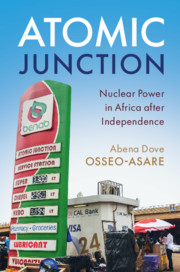Book contents
- Atomic Junction
- Atomic Junction
- Copyright page
- Epigraph
- Contents
- Figures
- Preface: Nuclear Reveries
- Acknowledgments
- Abbreviations
- 1 Introduction: “No Country has Monopoly of Ability”
- 2 Nuclear Winds: Particles without Boundaries
- 3 Scientific Equity: Physics from the Soviets
- 4 Atomic Reactors: A Fission Facility for Ghana
- 5 Radiation Within: Monitoring Particles in Bodies
- 6 Atomic Lands: Risks on a Nuclear Frontier
- Epilogue: Nuclear Power at the Crossroads
- Notes
- Persons Cited and Consulted
- Works Cited and Consulted
- Index
6 - Atomic Lands: Risks on a Nuclear Frontier
Published online by Cambridge University Press: 12 September 2019
- Atomic Junction
- Atomic Junction
- Copyright page
- Epigraph
- Contents
- Figures
- Preface: Nuclear Reveries
- Acknowledgments
- Abbreviations
- 1 Introduction: “No Country has Monopoly of Ability”
- 2 Nuclear Winds: Particles without Boundaries
- 3 Scientific Equity: Physics from the Soviets
- 4 Atomic Reactors: A Fission Facility for Ghana
- 5 Radiation Within: Monitoring Particles in Bodies
- 6 Atomic Lands: Risks on a Nuclear Frontier
- Epilogue: Nuclear Power at the Crossroads
- Notes
- Persons Cited and Consulted
- Works Cited and Consulted
- Index
Summary
This chapter considers how Ghanaian citizens experience nuclear power in the Kwabenya environs. It establishes the setting of Atomic Junction, through archival evidence of territorial disputes in a borderland area home to Guan, Akan, and Ga families. From the 1960s, Ghanaian scientists, inspired by Nkrumah’s grand plan settled in the area to manage the Ghana Atomic Energy Commission. While they did not obtain the GHARR-1 until 1994, they led local families to believe that a reactor was installed around 1966. Given this widespread misunderstanding, the chapter asks how have people living near the reactor interpreted life on a nuclear frontier, or what Joe Masco has termed the “nuclear borderlands”? The chapter interprets how Ghanaians in Haatso, Kwabenya and other villages near the nuclear exclusion zone relate their experience with Atomic Lands (i.e. GAEC property) to the advent of nuclear spaces around the world where the potential for radioactivity excludes populations. It stresses the greater risk posed by petrol stations on the Haatso-Atomic Road, culminating in the 2017 explosion of a petrol tanker and a mushroom cloud at Atomic Junction.
Keywords
- Type
- Chapter
- Information
- Atomic JunctionNuclear Power in Africa after Independence, pp. 139 - 169Publisher: Cambridge University PressPrint publication year: 2019

